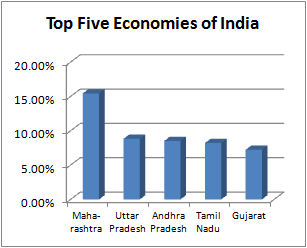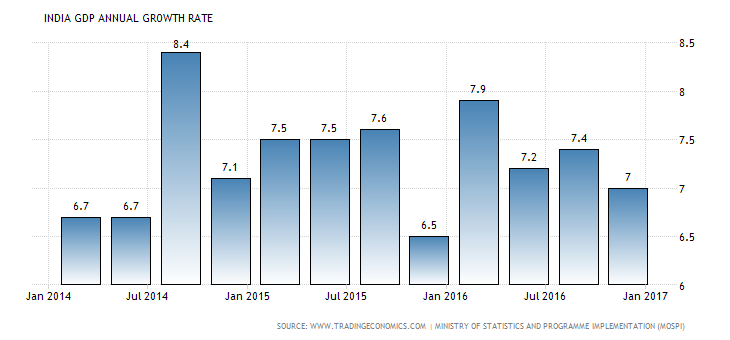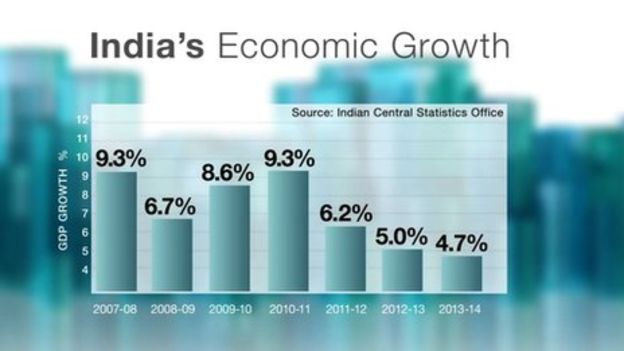Introduction
India has emerged as the fastest growing major economy in the world as per the Central Statistics Organisation (CSO) and International Monetary Fund (IMF). The Government of India has forecasted that the Indian economy will grow by 7.1 percent in FY 2016-17. As per the Economic Survey 2016-17, the Indian economy should grow between 6.75 and 7.5 percent in FY 2017-18. The improvement in India’s economic fundamentals has accelerated in the year 2015 with the combined impact of strong government reforms, Reserve Bank of India’s (RBI) inflation focus supported by benign global commodity prices.
India’s consumer confidence index stood at 136 in the fourth quarter of 2016, topping the global list of countries on the same parameter, as a result of strong consumer sentiment, according to market research agency, Nielsen.
Moody’s has affirmed the Government of India’s Baa3 rating with a positive outlook stating that the reforms by the government will enable the country to perform better compared to its peers over the medium term.

Market size
India’s gross domestic product (GDP) grew by 7 per cent year-on-year in October-December 2016 quarter, which is the strongest among G-20 countries, as per Organisation for Economic Co-operation and Development (OECD) Economic Survey of India, 2017. According to IMF World Economic Outlook Update (January 2017), Indian economy is expected to grow at 7.2 per cent during FY 2016-17 and further accelerate to 7.7 per cent during FY 2017-18.
The tax collection figures between April 2016 and January 2017 show an increase in Net Indirect taxes by 16.9 percent and an increase in Net Direct Taxes by 10.79 per cent year-on-year, indicating a steady trend of healthy growth. The total number of e-filed Income Tax Returns rose 21 percent year-on-year to 42.1 million in 2016-17 (till 28.02.17), whereas the number of e-returns processed during the same period stood at 43 million.
India’s labor force is expected to touch 160-170 million by 2020, based on the rate of population growth, increased labor force participation, and higher education enrollment, among other factors, according to a study by ASSOCHAM and Thought Arbitrage Research Institute.
India’s foreign exchange reserves stood at US$ 366.781 billion as on March 17, 2017, as compared to US$ 360 billion by end of March 2016, according to data from the RBI.
Recent Developments
- NITI Aayog, Department of Industrial Policy & Promotion (DIPP) and Confederation of Indian Industry (CII) launched an “India Innovation Index” in line with the Global Innovation Index (GII) to rank states based on innovation by capturing innovation data from all Indian states and updating them regularly.
- The Union Cabinet, Government of India, has approved the Central Goods and Services Tax (CGST), Integrated GST (IGST), Union Territory GST (UTGST), and Compensation Bill.
- The Government of India plans to auction 280 mines with an estimated mineral value of over Rs 10 lakh crore (US$ 153.64 billion) in the fiscal year 2017-18, and also use drone technology to prepare topography maps and inspect mines.
- Indian merchandise exports registered a growth of 17.48 per cent year-on-year in February 2017 at US$ 24.49 billion, according to the data from Ministry of Commerce & Industry.
- Retail price inflation for February 2017 was reported at 3.65 percent, compared to 5.26 percent a year ago, as per CSO.
- India’s industry output grew 2.74 per cent year-on-year in January 2017, led by a good performance in the capital goods sector which registered a 10.7 per cent year-on-year growth.

India GDP Annual Growth Rate
The Indian economy advanced 7 percent year-on-year in the last three months of 2016, slowing from an upwardly revised 7.4 percent rise in the previous quarter but beating expectations of a 6.4 percent growth. The expansion was mainly driven by a surge public spending and agriculture. The GDP is expected to grow 7.1 percent in the fiscal year ending in March 2017. GDP Annual Growth Rate in India averaged 6.10 percent from 1951 until 2016, reaching an all-time high of 11.40 percent in the first quarter of 2010 and a record low of -5.20 percent in the fourth quarter of 1979.
Credit – ibef
Credit – tradingeconomics


